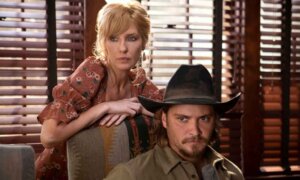NR | 1h 39m| Documentary, Biography, Film History | 2024
Recognized by most audiences, historians, and critics as one of the film industry’s premier “Golden Age” movie stars, Humphrey Bogart starred in many timeless classics and left behind a legacy few performers can match.
I stop short in declaring him a “great” actor, because he wasn’t. He was, however, an extremely smart one. Much like Clint Eastwood and Brad Pitt after him, Bogart was keenly aware of his thespian limitations. He rarely attempted to fool himself or audiences by taking on a role that exceeded his skill set.
What most people (including me) don’t know, was that Bogart attempted to “make it” in show business four times. This is the biggest takeaway I had after watching the documentary “Bogart: Life Comes in Flashes” (“Flashes”).
Directed by Kathryn Ferguson (the Sinead O’Connor bio-doc “Nothing Compares”), “Flashes” covers the already-known highlights in Bogart’s personal life and career and precedes this with all that took place before he became a household name.

Humphrey Bogart as a baby with his mother Maud. (Alamy Stock Photo)
Privileged Childhood
Given his later success playing tough guys, gangsters, and loners, one might surmise that Bogart had a lower-class upbringing. But the opposite was true. Born on Christmas Day in 1899 to a prominent Upper West Side surgeon (Belmont) and mother Maud, perhaps the most popular (and highest-paid) magazine illustrator of the era. The family (including two younger sisters) also spent time at a summer home on a 55-acre estate in Upstate New York.
Bogart’s “entertainment” career began as infant when he was chosen by Maud to be a model. This often required him to be dressed in “dainty” outfits, something he would reflect on with great disdain in his later years. The air of the Bogart households was chilly and emotionally distant. Physical displays of affection were extremely rare.
After a stint in the Navy during World War I, Bogart took a job as a stage manager at a theater on Broadway which often put on productions starring Helen Menken. Impressed by his work ethic and lack of being star struck in her presence, Menken pulled some strings and got him a bit part in “Swifty,” his second play. The pair married in 1926, but divorced less than two years later.

Humphrey Bogart and Lauren Bacall at home playing chess. (Masheter Movie Archive/Alamy Stock Photo)
The Breakthrough
On the basis of two short films, Bogart signed a lucrative five-year contract with Fox in 1929. This yielded an equal number of features over three years, none of them very successful. Disenchanted, Bogart returned to stage work in New York. In 1935, he finally got his big break as the lead opposite Leslie Howard in “The Petrified Forest.”
A year later, “The Petrified Forest” was adapted into a Warner Bros. feature film with Bogart and Howard reprising their roles, along with Bette Davis, and it was an instant hit. At age 37, Bogart had finally arrived.

(L–R) Bette Davis, Leslie Howard, and Humphrey Bogart, in “The Petrified Forest.” (Public Domain)
Ferguson and her co-writer (also producer) Eleanor Emptage take a few considerable chances during the nearly 100-minute running time and some of these pay off.
The filmmaker’s biggest gamble was with a nonlinear presentation. They bookend the movie with footage from Bogart’s 1957 funeral, attended by a who’s who of Hollywood royalty, which offers a fitting “full-circle” experience.
Voice Bogie
Similar to the recent “
My Name is Alfred Hitchcock,” Ferguson enlists the services of voice performer Enzo Squillino Jr. to read passages from Bogart’s assorted notes and diaries over multiple still photos and archival videos. He does a good enough job trying to sound like Bogart and deserves an “A” for effort.
A good 20 minutes of the movie is dedicated to Bogart and his time with his second wife (Mary Philips) and third wife (Mayo Methot). Had the movie been two hours in length this wouldn’t have been an issue, but as it is now, it feels as if it could have been cut.
On the flipside, Ferguson spends just the right amount time with his fourth wife (Lauren Bacall) and her storybook romance with Bogart that lasted until his death.

Bogart and Bacall in “The Big Sleep.” (Public Domain)
Greatest Hits
The final 30 minutes is the best part of the movie where the filmmakers concentrate on the hits: “The Maltese Falcon,” “The Big Sleep,” “Casablanca,” “In a Lonely Place,” “To Have and Have Not,” “The Caine Mutiny,” and the segment on the lead up to and the glorious aftermath of “The African Queen,” the movie for which Bogart won his sole Academy Award.
I’m not a big fan of spending more time on any subject of any movie (especially documentaries) than is needed. Waste, fat, and filler are often used to give the audience the idea they’re getting more, and more is always better, right? No, it’s not. Streamlined efficiency is better.
In this case, 100 minutes is not nearly enough time to properly document the life and career of someone as legendary and influential as Bogart. His story needs a Netflix or HBO mini-series treatment running three to four hours, maybe more. “Flashes” does well at presenting the bullet points, but is far from definitive.
The film opens in select theaters on Nov. 15.
‘Bogart: Life Comes in Flashes’
Documentary
Director: Kathryn Ferguson
Running Time: 1 hour, 39 minutes
Release Date: Nov. 15, 2024
Rating: 3 1/2 stars out of 5
What arts and culture topics would you like us to cover? Please email ideas or feedback to features@epochtimes.nyc













